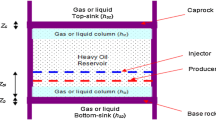Abstract
Wellbore temperatures decrease dramatically during simulated reservoir volume (SRV) fracturing, which endangers the casing. Here, we establish a calculational model for wellbore temperatures based on heat-conduction theory and the characteristics of SRV fracturing. The results demonstrate the following relationships between the wellbore temperature and various factors: (1) With increasing pumping time, the wellbore temperature decreases gradually. (2) Increasing the pump rate can cause the wellbore temperature decrease. (3) As the initial temperature of injection fluid and the geothermal gradient increase, the wellbore temperature rises sharply. (4) The wellbore temperature increases slowly with the casing diameter. We analyze field tests and case studies in this paper, and the results show excellent agreement between the predictions and the measurements. The theoretical model can thus predict the wellbore temperature satisfactorily for fracturing operations.
Similar content being viewed by others
References
Eickmeier, J.R.; Ersoy, D.; Ramey, H.J.: Wellbore temperatures and heat losses during production or injection operations. J. Can. Pet. Technol. 9(02), 115–121 (1970)
Hongxun, W.; Ping, L.: Numerical calculation method of wellbore temperature during hydraulic fracturing. Acta Pet. Sin. 02, 91–99 (1987)
Mou, Y.; Yingfeng, M.; Gao, L.; Jianmin, D.; Xiangyang, Z.: A transient heat transfer model of wellbore and formation during the whole drilling process. Pet. Sin. 02, 366–371 (2013)
Zhonglan, T.; Lin, S.; Lei, Q.: Research of and countermeasure for wellbore integrity of shale gas horizontal well. Nat. Gas Ind. 35(09), 70–76 (2015)
Daneshy, A.A.: Impact of off-balance fracturing on borehole stability and casing failure. SPE Western Regional Meeting. Society of Petroleum Engineers (2005)
Lian, Z.; Yu, H.; Lin, T.; et al.: A study on casing deformation failure during multi-stage hydraulic fracturing for the stimulated reservoir volume of horizontal shale wells[J]. J. Nat. Gas Sci. Eng. 23, 538–546 (2015)
Stegent, N.; Ingram, S.; Callard, J.: Hydraulic Fracture Stimulation Design Considerations and Production Analysis. In: SPE Hydraulic Fracturing Technology Conference. Society of Petroleum Engineers (2011)
Sugden, C.: SPE, Blade Energy Partners. Special Consideration in the Design Optimization of High Rate, Multistage Fractured Shale Wells. In: 2012 IADC/SPE Drilling Conference and Exhibition, USA:SPE (2012)
Zhilun, X.: Elasticity. Higher Education Press, Beijing (2006)
Author information
Authors and Affiliations
Corresponding author
Rights and permissions
About this article
Cite this article
Dong, W., Shen, R. & Liang, Q. Model Calculations and Factors Affecting Wellbore Temperatures During SRV Fracturing. Arab J Sci Eng 43, 6475–6480 (2018). https://doi.org/10.1007/s13369-018-3269-0
Received:
Accepted:
Published:
Issue Date:
DOI: https://doi.org/10.1007/s13369-018-3269-0




